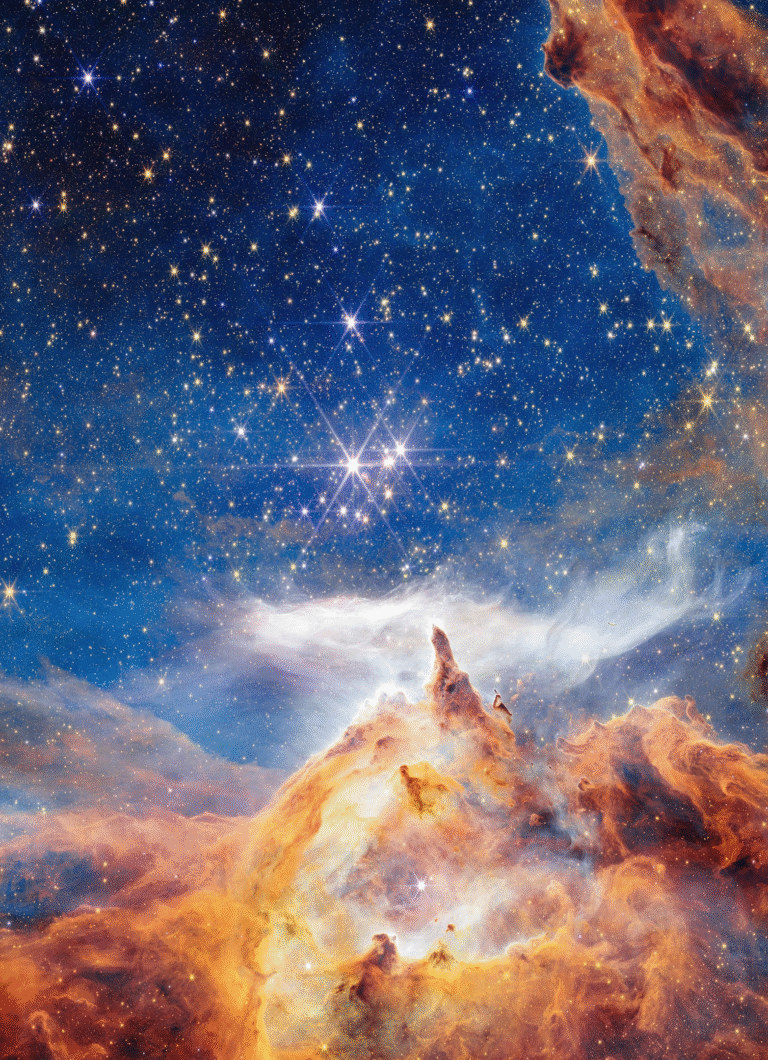The Vera Rubin Observatory Discovers a Massive Stellar Stream Stretching From Galaxy M61

The Vera C. Rubin Observatory (VRO) has just made its first major discovery—an enormous stellar stream extending from the spiral galaxy Messier 61 (M61) in the Virgo Cluster. What makes this remarkable is that the observatory hasn’t even officially begun its main scientific mission, the Legacy Survey of Space and Time (LSST). This early find gives us a glimpse of the kind of breakthroughs that Rubin’s ultra-sensitive eyes will soon deliver on a regular basis.
A Galaxy in the Virgo Cluster Shows Its Hidden Tail
M61, also known as NGC 4303, is a large spiral galaxy located roughly 52 million light-years away in the Virgo Cluster. It’s similar in many ways to our own Milky Way, with a bright central bulge, spiral arms, and ongoing star formation. Although astronomers have studied M61 for decades, the new First Look images from Rubin’s powerful camera have revealed something never seen before—a long, narrow stellar stream stretching outward from the galaxy’s northern side.
This faint stream extends for about 50 kiloparsecs, or roughly 163,000 light-years—making it much longer than any stellar stream known in the Milky Way. It even dwarfs the famous Sagittarius Stream, which wraps around our own galaxy and spans tens of thousands of light-years. The Rubin images show that this new stream ends in a plume-like structure roughly 9 by 4 kiloparsecs (about 30,000 by 13,000 light-years) across, hinting at a complex and chaotic history of galactic interaction.
The Discovery Behind the Discovery
The study describing this find is titled “A Stellar Stream Around the Spiral Galaxy Messier 61 in Rubin First Look Imaging”, led by Aaron Romanowsky of San José State University. The paper will appear in the Research Notes of the American Astronomical Society and is currently available on arXiv.
The Rubin Observatory captured its first light in June 2025, when its main camera—one of the most advanced astronomical imagers ever built—took its initial “Virgo First Look” images during the commissioning phase. The observatory, located in Chile, is still testing its instruments before beginning the full LSST survey. Yet even these preliminary observations have started unveiling previously hidden structures in nearby galaxies.
Among these early images, the M61 stellar stream stood out immediately as one of the most intriguing features. The researchers describe it as a long, faint, and linear structure composed of stars that were once part of a smaller galaxy.
What Are Stellar Streams?
A stellar stream forms when a smaller galaxy or globular cluster ventures too close to a larger galaxy and is torn apart by gravitational tidal forces. As the smaller system disintegrates, its stars are stretched out along its orbit, creating a ribbon-like trail that can loop around the host galaxy for billions of years.
Our Milky Way has several such streams, including those from the Sagittarius Dwarf Galaxy, the GD-1 stream, and the Palomar 5 stream. These structures help astronomers map out the gravitational field of our galaxy and test models of dark matter distribution.
Now, thanks to the Vera Rubin Observatory, we are seeing a similar phenomenon around another Milky Way-like spiral galaxy, giving us a new external laboratory for studying how galaxies grow through hierarchical assembly—the gradual merging of smaller galaxies into larger ones.
What Makes the M61 Stream Special
The newly detected stream in M61 is exceptional for several reasons. First, its sheer size—163,000 light-years—is extraordinary. That’s roughly one and a half times the diameter of the Milky Way itself. Second, it’s incredibly faint, with a measured surface brightness of about μg ≈ 28 magnitudes per square arcsecond, making it invisible in most previous telescope surveys.
The estimated stellar mass of the stream is around 2 × 10⁸ solar masses, suggesting that its progenitor was a dwarf galaxy, not just a star cluster. Astronomers estimate that the original galaxy had an infall halo mass of approximately 8 × 10¹⁰ solar masses before being devoured by M61.
This ancient merger event may have had profound effects on M61 itself. The same infalling dwarf could have triggered the formation of M61’s central bar, fueled a starburst about 10 million years ago, and perhaps even activated its central black hole, leading to active galactic nucleus (AGN) activity.
This type of influence is reminiscent of what happened in our own galaxy when the Sagittarius Dwarf Galaxy repeatedly plunged through the Milky Way’s disk, stirring up massive bursts of star formation and altering the structure of the galaxy’s bar.
Why This Matters for Astronomy
Discoveries like this one show why the Vera C. Rubin Observatory is such an eagerly anticipated addition to astronomy. Its enormous 3.2-gigapixel camera and 8.4-meter mirror make it uniquely capable of capturing extremely faint, wide-field structures—exactly the kind of features that reveal the hidden past of galaxies.
The Legacy Survey of Space and Time (LSST), scheduled to begin soon, will scan the entire southern sky repeatedly over ten years, creating a massive dataset of deep, high-resolution images. This will allow scientists to study the formation and evolution of galaxies, detect transient events like supernovae and near-Earth asteroids, and even map dark matter through the gravitational influence it exerts on visible matter.
The M61 stream, discovered during the commissioning phase before the main survey even began, is a clear demonstration of the observatory’s sensitivity and promise. It suggests that we’ve only begun to glimpse the “hidden skeletons” of galaxies—stellar streams, tidal tails, and faint halos that trace the cosmic mergers that built the modern universe.
The Bigger Picture: A Universe Built by Mergers
The hierarchical model of galaxy formation proposes that large galaxies are built through the steady accretion of smaller ones. Streams like the one around M61 are direct evidence of this process in action. By studying these features, astronomers can test models of dark matter halos, measure how galaxies acquire their mass, and understand the timing and impact of past mergers.
Each stream carries a fossil record of its origin: the chemical composition of its stars, their orbital motions, and the stream’s shape all provide clues to when and how the merger occurred. As Rubin continues to uncover more of these streams in other galaxies, astronomers will be able to build a statistical picture of galactic evolution across the nearby universe.
What Comes Next
The team behind this discovery plans to conduct follow-up observations to confirm the physical properties of the stream. This will likely include spectroscopic studies to determine the stars’ velocities and chemical abundances, which will help identify the progenitor galaxy and estimate how long ago the disruption took place.
Further analysis will also explore the 3D geometry of the stream and its orbital path around M61. Combined with detailed models, this will reveal how M61’s gravitational potential has evolved and how much dark matter surrounds it.
The early detection of this faint, extended structure also suggests that many other nearby galaxies could be surrounded by similar stellar remnants—simply waiting for Rubin’s unprecedented vision to reveal them.
A New Era for Galactic Archaeology
That’s the real story here: the Rubin Observatory is already changing our view of the nearby universe, even before its official science operations begin. Its ability to detect low-surface-brightness features means we’re about to witness an explosion of discoveries about how galaxies form, evolve, and interact.
If the first light images already revealed something as striking as a 160,000-light-year-long stellar stream, it’s exciting to imagine what the full ten-year LSST survey will uncover—dozens, maybe hundreds of such structures, rewriting our understanding of how galaxies like M61 and the Milky Way came to be.
Research Reference:
A Stellar Stream Around the Spiral Galaxy Messier 61 in Rubin First Look Imaging – Romanowsky et al. (2025)





